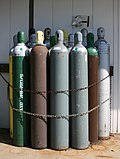Gas cylinder
Gas Cylinder
A gas cylinder or tank is a pressure vessel used to store gases at above atmospheric pressure. High-pressure gas cylinders are also called bottles. Inside the cylinder, the stored contents may be in a state of compressed gas, vapor over liquid, supercritical fluid, or dissolved in a substrate material, depending on the physical characteristics of the contents. A typical gas cylinder design is elongated, standing upright on a flattened bottom end, with the valve and fitting at the top for connecting to the receiving apparatus.
Types of Gas Cylinders[edit]
Gas cylinders can be broadly classified into two categories based on the type of gas they contain: flammable gases and non-flammable gases. Flammable gases such as hydrogen, acetylene, and propane are used in industrial processes requiring heat. Non-flammable gases like nitrogen, oxygen, and carbon dioxide are used in various applications ranging from medical therapies to beverage carbonation.
High-Pressure Cylinders[edit]
High-pressure cylinders are made from materials capable of withstanding high pressures, such as steel or aluminum. They are commonly used for industrial, medical, and scientific applications. The contents are stored at pressures typically above 2000 psi (pounds per square inch).
Low-Pressure Cylinders[edit]
Low-pressure cylinders are designed for gases that are stored in liquid form at lower pressures. These cylinders are often made of composite materials to reduce weight, making them easier to handle. An example of a gas stored in this type of cylinder is liquefied petroleum gas (LPG).
Safety and Regulations[edit]
Handling and storage of gas cylinders are subject to regulations and standards, which may vary by country. These regulations are designed to prevent accidents and injuries that can result from the high pressure inside the cylinders or from the chemical properties of the gases. Safety measures include proper labeling, regular inspections, and adherence to storage guidelines.
Labeling[edit]
Each cylinder must be clearly labeled with the type of gas it contains and the necessary safety precautions. This is crucial for preventing accidents due to the misuse of the cylinder or its contents.
Inspections[edit]
Regular inspections are required to ensure that gas cylinders are in good condition and free from defects. Inspections typically include checking for leaks, corrosion, and structural integrity.
Uses of Gas Cylinders[edit]
Gas cylinders have a wide range of uses across various industries. In the medical field, oxygen cylinders are crucial for respiratory therapy and anesthesia. In the food and beverage industry, carbon dioxide cylinders are used for carbonating drinks. Industrial applications include welding and cutting processes, where acetylene and oxygen cylinders are commonly used.
Environmental Considerations[edit]
The production, transportation, and disposal of gas cylinders can have environmental impacts. It is important to follow proper recycling and disposal procedures to minimize these impacts. Additionally, the choice of gas and cylinder type can affect the overall environmental footprint of their use.
Conclusion[edit]
Gas cylinders are essential tools in many industrial, medical, and scientific applications. Proper handling, storage, and disposal are crucial to ensure safety and minimize environmental impact. As technology advances, new materials and designs are being developed to improve the safety and efficiency of gas cylinders.
-
Gas cylinder
-
Gas cylinder
-
Gas cylinder
-
Gas cylinder
-
Gas cylinder
-
Gas cylinder
-
Gas cylinder
-
Gas cylinder
-
Gas cylinder
-
Gas cylinder
-
Gas cylinder
-
Gas cylinder
Ad. Transform your life with W8MD's Budget GLP-1 injections from $75


W8MD offers a medical weight loss program to lose weight in Philadelphia. Our physician-supervised medical weight loss provides:
- Weight loss injections in NYC (generic and brand names):
- Zepbound / Mounjaro, Wegovy / Ozempic, Saxenda
- Most insurances accepted or discounted self-pay rates. We will obtain insurance prior authorizations if needed.
- Generic GLP1 weight loss injections from $75 for the starting dose.
- Also offer prescription weight loss medications including Phentermine, Qsymia, Diethylpropion, Contrave etc.
NYC weight loss doctor appointmentsNYC weight loss doctor appointments
Start your NYC weight loss journey today at our NYC medical weight loss and Philadelphia medical weight loss clinics.
- Call 718-946-5500 to lose weight in NYC or for medical weight loss in Philadelphia 215-676-2334.
- Tags:NYC medical weight loss, Philadelphia lose weight Zepbound NYC, Budget GLP1 weight loss injections, Wegovy Philadelphia, Wegovy NYC, Philadelphia medical weight loss, Brookly weight loss and Wegovy NYC
|
WikiMD's Wellness Encyclopedia |
| Let Food Be Thy Medicine Medicine Thy Food - Hippocrates |
Medical Disclaimer: WikiMD is not a substitute for professional medical advice. The information on WikiMD is provided as an information resource only, may be incorrect, outdated or misleading, and is not to be used or relied on for any diagnostic or treatment purposes. Please consult your health care provider before making any healthcare decisions or for guidance about a specific medical condition. WikiMD expressly disclaims responsibility, and shall have no liability, for any damages, loss, injury, or liability whatsoever suffered as a result of your reliance on the information contained in this site. By visiting this site you agree to the foregoing terms and conditions, which may from time to time be changed or supplemented by WikiMD. If you do not agree to the foregoing terms and conditions, you should not enter or use this site. See full disclaimer.
Credits:Most images are courtesy of Wikimedia commons, and templates, categories Wikipedia, licensed under CC BY SA or similar.
Translate this page: - East Asian
中文,
日本,
한국어,
South Asian
हिन्दी,
தமிழ்,
తెలుగు,
Urdu,
ಕನ್ನಡ,
Southeast Asian
Indonesian,
Vietnamese,
Thai,
မြန်မာဘာသာ,
বাংলা
European
español,
Deutsch,
français,
Greek,
português do Brasil,
polski,
română,
русский,
Nederlands,
norsk,
svenska,
suomi,
Italian
Middle Eastern & African
عربى,
Turkish,
Persian,
Hebrew,
Afrikaans,
isiZulu,
Kiswahili,
Other
Bulgarian,
Hungarian,
Czech,
Swedish,
മലയാളം,
मराठी,
ਪੰਜਾਬੀ,
ગુજરાતી,
Portuguese,
Ukrainian












